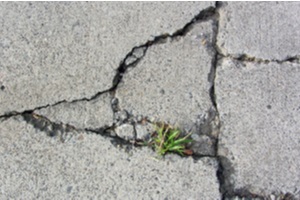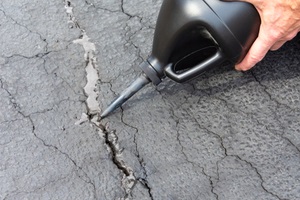 Concrete may be one of the most durable driveway materials on the market, but it is still vulnerable to developing cracks and other issues over time. Thankfully, fixing driveway cracks is a fairly straightforward process that can often be carried out on your own to extend the life of your driveway and enhance its appearance.
Concrete may be one of the most durable driveway materials on the market, but it is still vulnerable to developing cracks and other issues over time. Thankfully, fixing driveway cracks is a fairly straightforward process that can often be carried out on your own to extend the life of your driveway and enhance its appearance.
Determining The Size Of Cracks In Your Driveway
First, it is important to understand what type of cracks you are dealing with in your driveway to determine if repairing it is a job that you can handle on your own or if it is best to call in professionals.
Cosmetic Cracks
Cosmetic cracks are the easiest types to fix. Also known as crazing, very fine cracks on the surface of your driveway could be a sign that the concrete surface dried too quickly after being poured. These cracks do not usually indicate an underlying structural problem and can be taken care of by applying a resurfacing product over the driveway following a quick cleaning with a high-powered pressure washer.
Small Cracks
Small cracks that do not exceed 1/4 inch may occur due to shrinkage as the driveway cures. These types of cracks could eventually get bigger if water gets inside of them and then freezes and expands, so the best course of action is to seal them with a sealant product created specifically for this purpose.
Large Cracks
Larger cracks require a more involved process to address. The trick to getting this right is undercutting the sides of the crack so that it has an inverted V shape that makes the repair material bond better to the driveway. Here is a look at the steps you should take to repair bigger cracks in your driveway.
Prepare The Area
First, you should use a masonry chisel and a hammer to chisel the crack and widen its base while dislodging any loose material that you can remove from the old concrete.
Then, use a wire brush to remove all debris from within the crack. You may also use a pressure washer or garden hose with a spray nozzle to get the crack as clean as possible. Make sure that all water and debris have been removed from the crack with help from a wet/dry shop vacuum or a simple brush. It is okay if the surface is wet, but make sure there are no pools of water, dust or grit in the crack.
Mix And Apply Patching Compound
 Next, you will want to mix your concrete patching compound. Be sure to follow the directions listed by the manufacturer on the product as different formulations require different steps for proper mixing.
Next, you will want to mix your concrete patching compound. Be sure to follow the directions listed by the manufacturer on the product as different formulations require different steps for proper mixing.
Once you have mixed your concrete patching compound, you will want to trowel it into the crack. This is a very simple procedure that involves stabbing the trowel into the compound to remove any air pockets and help the patching material to get as deep into the crack as possible. You’ll want to fill the crack all the way up to the concrete surface surrounding it.
Smooth And Let Dry
Next, you should smooth the surface of the area you just patched using a trowel. It is best to feather the compound into the concrete surrounding it for a more natural look. If your driveway has a textured surface, you can brush the surface of the area you filled with patching compound in order to match the rest of the driveway using a dry paint brush.
Then, allow the compound to cure according to the directions. Once it has dried completely, you can paint or seal the surface of the patch as well as the area surrounding it, if desired.
Choosing A Compound To Repair Driveway Cracks
If you want to be able to use your driveway as quickly as possible, you will want to look for a fast-set or rapid crack filler. Some concrete patching compounds can harden in just a couple of hours, while others could take several days or even a week to fully cure and dry. Although temperature and humidity also influence how long it takes, the formulation is a key determinant, and most products will specify how long it takes on the label.
You might also look for crack fillers that are self-leveling, which means that the filler will settle evenly into the crack after it has been filled. However, this is not necessary as a putty knife can also be used to smooth out the crack filler and scrape off any excess. You may also be able to find products that are textured or colored in the same shade as your concrete so that you can blend it in as smoothly as possible with your existing driveway.
When To Call The Professionals
 If your driveway has jagged cracks that are more than an inch wide or are noticeably higher on one side than the other because of sinking or heaving, it is best to call in the professionals. If your driveway’s surface is cracked all the way through and you are seeing signs of instability, it may be unsafe to continue using your driveway. In some cases, it may be necessary to have a section of the driveway broken up, removed and repoured, and this is not a job that you should attempt on your own.
If your driveway has jagged cracks that are more than an inch wide or are noticeably higher on one side than the other because of sinking or heaving, it is best to call in the professionals. If your driveway’s surface is cracked all the way through and you are seeing signs of instability, it may be unsafe to continue using your driveway. In some cases, it may be necessary to have a section of the driveway broken up, removed and repoured, and this is not a job that you should attempt on your own.
If your driveway is in a serious state of disrepair, there may be no getting around having a new driveway installed. However, this will give you the opportunity to change its size, shape or design to one that better suits your needs or the aesthetics of your home.
Reach Out To The Northern Virginia Driveway Experts
Get in touch with the concrete experts at Dirt Connections for help with all of your concrete driveway paving needs. We can help with everything from making simple repairs to existing concrete driveways to leveling, widening and carrying out full driveway replacements. We have the tools and expertise needed to install and maintain your driveway and keep it looking beautiful for many years to come. Reach out today to get started!
Summary

Dirt Connections was started with one goal in mind: providing quality residential and commercial construction services to clients on time and on budget. Reach out for more information on how we can support your next project.
For your convenience our estimates are free and by appointment. Call 703-940-9949 for a free estimate today!









































